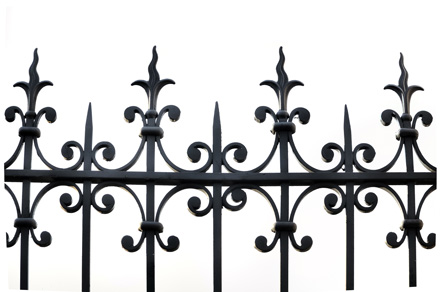Ironwork in buildings
Iron is the chemical element most commonly found on Earth by mass, forming much of the Earth’s outer and inner core. On the Periodic Table it has the symbol ‘Fe’ and atomic number 26. Pure iron is relatively soft but it is significantly hardened and strengthened during the smelting process by impurities such as carbon.
The term 'ironwork' refers to any architectural component or feature of a building, principally used for decorative purposes, that is made of iron.
While the use of iron for building purposes dates back to early civilisations, its use for decoration became more widespread between the 16th and 19th centuries. Ironwork began to be used during the medieval period for defensive purposes, but became more ornate and decorative in the Baroque and Rococo architectural periods, particularly for:
The two main types of ironwork are:
Wrought iron is a very low carbon metal made by intensive hand work using small scale production methods. The term 'cast iron' refers to a range of iron-carbon alloys, with a carbon content that is typically between 2 and 4%. Cast iron is manufactured by re-melting pig iron along with quantities of limestone, silicon and carbon (and sometimes scrap steel).
The term ‘ironworks’ refers to a place where iron is smelted or where iron products are manufactured.
NB the term ironwork can also be used to refer to items such as manhole covers, drain covers and so on used in the construction of highways.
[edit] Related articles on Designing Buildings Wiki
- Aluminium.
- Cast iron.
- Coal holes, pavement lights, kerbs and utilities and wood-block paving.
- Code of Practice for Ironwork Systems Installation and Refurbishment.
- Conservation of Architectural Ironwork.
- Difference between cast iron and wrought iron.
- Failure of cast iron beams.
- Iron.
- Metal.
- Railings.
- Steel.
- Wrought iron.
- Wrought iron spindles for external stairs.
Featured articles and news
One of the most impressive Victorian architects. Book review.
RTPI leader to become new CIOB Chief Executive Officer
Dr Victoria Hills MRTPI, FICE to take over after Caroline Gumble’s departure.
Social and affordable housing, a long term plan for delivery
The “Delivering a Decade of Renewal for Social and Affordable Housing” strategy sets out future path.
A change to adoptive architecture
Effects of global weather warming on architectural detailing, material choice and human interaction.
The proposed publicly owned and backed subsidiary of Homes England, to facilitate new homes.
How big is the problem and what can we do to mitigate the effects?
Overheating guidance and tools for building designers
A number of cool guides to help with the heat.
The UK's Modern Industrial Strategy: A 10 year plan
Previous consultation criticism, current key elements and general support with some persisting reservations.
Building Safety Regulator reforms
New roles, new staff and a new fast track service pave the way for a single construction regulator.
Architectural Technologist CPDs and Communications
CIAT CPD… and how you can do it!
Cooling centres and cool spaces
Managing extreme heat in cities by directing the public to places for heat stress relief and water sources.
Winter gardens: A brief history and warm variations
Extending the season with glass in different forms and terms.
Restoring Great Yarmouth's Winter Gardens
Transforming one of the least sustainable constructions imaginable.
Construction Skills Mission Board launch sector drive
Newly formed government and industry collaboration set strategy for recruiting an additional 100,000 construction workers a year.
New Architects Code comes into effect in September 2025
ARB Architects Code of Conduct and Practice available with ongoing consultation regarding guidance.
Welsh Skills Body (Medr) launches ambitious plan
The new skills body brings together funding and regulation of tertiary education and research for the devolved nation.
Paul Gandy FCIOB announced as next CIOB President
Former Tilbury Douglas CEO takes helm.























